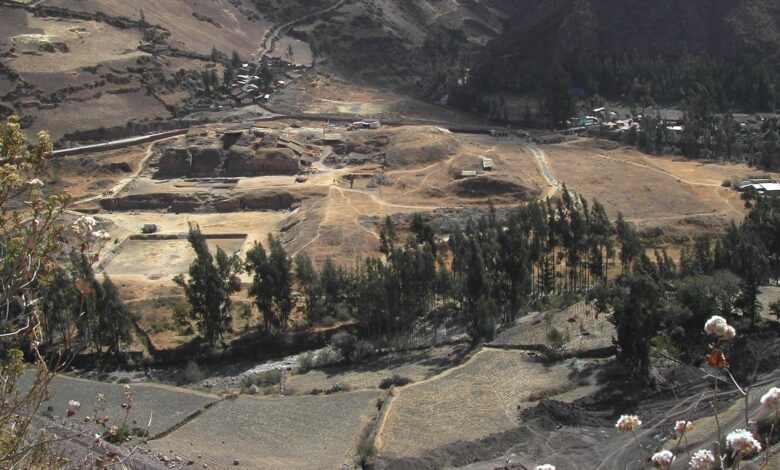Heavy hallucinogenic rituals solidified social castes in Pre-Incan Peru

The Chavín people of Peru, who inhabited the region roughly 2,000 years before the mighty Incan empire, have long been shrouded in mystery. Recent archaeological discoveries have shed light on their culture, revealing a society that used hallucinogens as part of their religious rituals to reinforce social hierarchy and maintain order.
The Chavín people, whose own name for themselves remains unknown, left behind a legacy of sophisticated agricultural techniques, impressive architecture, and intricate artwork that influenced their successors, the Incas. Their ceremonial center, Chavín de Huántar, located about 270 miles north of Lima, has been the focus of extensive archaeological research over the past three decades.
One of the most recent discoveries at Chavín de Huántar is a set of ancient snuff tubes carved from bone, which were found in small private chambers deep within the ceremonial complex. These tubes contained trace amounts of nicotine from wild tobacco plants and vilca bean residue, a hallucinogen similar to DMT (Dimethyltryptamine).
DMT is a naturally occurring psychedelic compound known for inducing intense hallucinations. While its effects are well-documented in shamanistic rituals among various Indigenous cultures in South America, the Chavín people appear to have reserved the use of psychoactive substances for a select few individuals, likely those in positions of power or authority.
According to Daniel Contreras, an anthropological archaeologist at the University of Florida and co-author of the study, the use of hallucinogens was not merely about experiencing visions but was part of a tightly controlled ritual that reinforced the social hierarchy within Chavín society. The discovery of the snuff tubes in private chambers suggests that these psychedelic rituals were reserved for a privileged few, adding an aura of mystique and exclusivity to the events.
In addition to the use of psychoactive substances, musical performances also played a significant role in Chavín rituals. Conch shell trumpets and specially designed rooms for acoustics indicate that sound was a crucial element in enhancing the mystical experiences at Chavín de Huántar.
Despite the elaborate ceremonial practices and the awe-inspiring monuments built by the Chavín people, their society eventually succumbed to a period of intense violence around 500–400 BCE, leading to their decline. The use of hallucinogens and other ritualistic practices may have helped maintain social order and justify inequality within Chavín society, but they were ultimately unable to prevent the upheaval and unrest that marked the end of their civilization.
The recent archaeological findings at Chavín de Huántar offer a glimpse into the complex religious and social dynamics of this ancient culture, highlighting the role of hallucinogens in shaping their beliefs and practices. As researchers continue to unravel the mysteries of the Chavín civilization, we gain a deeper understanding of the diverse and sophisticated societies that once thrived in the Andes Mountains of Peru. Experts believe that the collapse of the Chavín culture was followed by a period of violence, which may have been due to a transition from a theological to a secular organized society. This theory comes after over a century of archaeological investigation, where researchers have discovered that the Chavín likely served as a link between earlier, more egalitarian cultures and the large-scale, class-based empires that emerged in later eras in South America.
The Chavín culture, which thrived in the central Andes region of South America from around 900 BC to 200 BC, is known for its impressive architecture, intricate artwork, and sophisticated religious practices. The Chavín people worshipped a pantheon of deities and conducted elaborate rituals, including the use of hallucinogenic substances and human sacrifice.
However, around 200 BC, the Chavín culture began to decline, and evidence suggests that this decline was accompanied by a period of violence and social unrest. Archaeological sites from this period show signs of destruction, including burned buildings and evidence of warfare.
Experts believe that this period of violence may have been triggered by a shift from a theological society, where religious beliefs and practices played a central role in organizing society, to a more secular society where other factors, such as political power and economic inequality, became more important.
The transition from a theological to a secular society may have led to social upheaval as power dynamics shifted and traditional religious beliefs lost their influence. This could have created tensions within Chavín society, ultimately leading to conflict and violence.
Overall, the collapse of the Chavín culture and the subsequent period of violence provide valuable insights into the complexities of ancient societies and the factors that can contribute to their downfall. By studying the rise and fall of the Chavín culture, researchers can gain a better understanding of the dynamics of power, belief systems, and social organization in ancient civilizations. The power of positive thinking has long been touted as a key factor in achieving success and happiness in life. But what exactly does it mean to think positively, and how can we harness the power of our thoughts to create the life we desire?
Positive thinking is more than just repeating affirmations or looking on the bright side of things. It is a mindset that involves actively choosing to focus on the good in every situation, no matter how challenging or difficult it may be. This doesn’t mean ignoring or denying the negative aspects of life, but rather choosing to approach them with a constructive and optimistic attitude.
Research has shown that positive thinking can have a profound impact on our mental and physical well-being. Studies have found that people who maintain a positive outlook on life are more likely to experience lower levels of stress, better physical health, and greater overall life satisfaction. Positive thinking has also been linked to increased resilience, improved relationships, and greater success in achieving personal and professional goals.
So how can we cultivate a more positive mindset in our daily lives? One of the first steps is to become more aware of our thoughts and the impact they have on our emotions and behaviors. By paying attention to our inner dialogue and challenging negative or self-defeating thoughts, we can begin to shift our focus towards more positive and empowering beliefs.
Practicing gratitude is another powerful way to foster positive thinking. By taking the time to appreciate the good things in our lives, no matter how small they may seem, we can create a sense of abundance and joy that can help to counteract negative thinking patterns.
Setting goals and visualizing success can also be effective strategies for cultivating a positive mindset. By focusing on what we want to achieve and imagining ourselves already reaching our goals, we can create a sense of motivation and excitement that can propel us towards success.
Incorporating mindfulness practices, such as meditation or deep breathing exercises, can also help to quiet the mind and increase our ability to stay present and positive in the face of challenges.
Ultimately, the power of positive thinking lies in our ability to choose our thoughts and beliefs consciously. By cultivating a mindset of optimism, gratitude, and resilience, we can create the life we desire and overcome any obstacles that may come our way. So, the next time you find yourself facing a difficult situation, remember that your thoughts have the power to shape your reality – choose positivity and watch as your life begins to transform.





